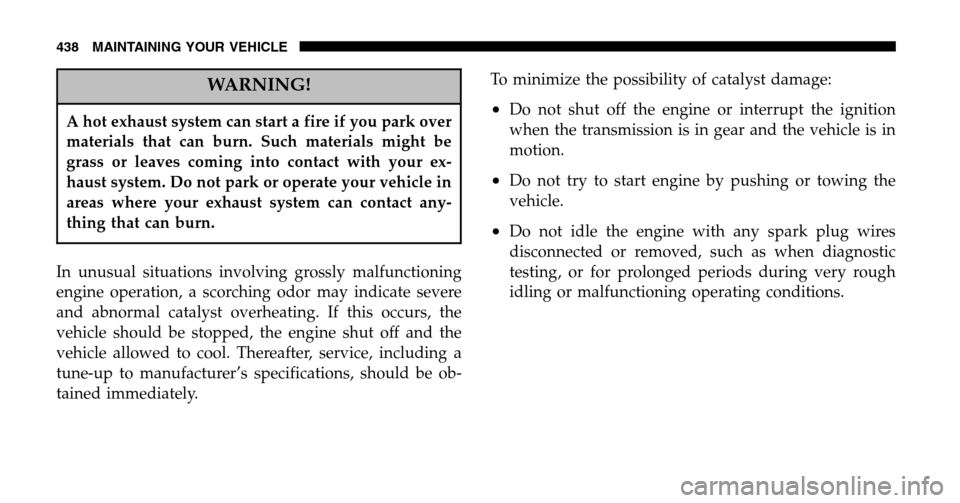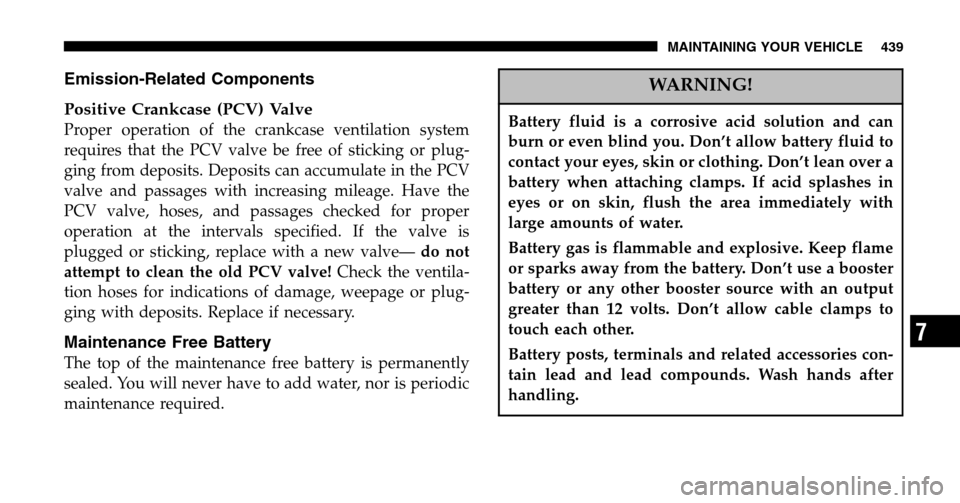Page 358 of 536

Gasoline/Oxygenate Blends
Some fuel suppliers blend unleaded gasoline with oxy-
genates such as 10% ethanol, MTBE and ETBE. Oxygen-
ates are required in some areas of the country during the
winter months to reduce carbon monoxide emissions.
Fuels blended with these oxygenates may be used in
your vehicle.
CAUTION!
DO NOT use gasolines containing METHANOL.
Gasoline containing methanol may damage critical
fuel system components.
MMT In Gasoline
MMT is a manganese-containing metallic additive that is
blended into some gasoline to increase octane. Gasolines
blended with MMT provide no performance advantage
beyond gasolines of the same octane number without
MMT. Gasolines blended with MMT reduce spark plug
life and reduce emission system performance. We recom-
mend that gasolines free of MMT be used in your vehicle.
The MMT content of gasoline may not be indicated on
the gasoline pump; therefore, you should ask your gaso-
line retailer whether or not his/her gasoline contains
MMT.
It is even more important to look for gasolines without
MMT in Canada because MMT can be used at levels
higher than allowed in the United States. MMT is pro-
hibited in Federal and California reformulated gasolines.
358 STARTING AND OPERATING
Page 366 of 536

NOTE:Intentional tampering with emissions control
systems can result in civil penalties being assessed
against you.
CAUTION!
Damage to the catalytic converter can result if your
vehicle is not kept in proper operating condition. In
the event of engine malfunction, particularly involv-
ing engine misfire or other apparent loss of perfor-
mance, have your vehicle serviced promptly. Contin-
ued operation of your vehicle with a severe
malfunction could cause the converter to overheat,
resulting in possible damage to the converter and
vehicle.
As with any vehicle, do not park or operate this vehicle in
areas where combustible materials such as grass or leaves
can come in contact with a hot exhaust system. A scorching odor may be detected if you continue to run
a malfunctioning engine. The odor may indicate severe
and abnormal catalyst overheating. If this occurs, the
vehicle should be stopped, the engine shut off and the
vehicle allowed to cool. Service, including a tune-up to
manufacturer’s specifications should be obtained imme-
diately.
To minimize the possibility of catalyst damage:
•Do not shut off the engine or interrupt the ignition
when the transmission is in gear and the vehicle is in
motion.
•Do not try to start engine by pushing or towing the
vehicle.
•Do not idle the engine with any spark plug wires
disconnected or removed, such as when diagnostic
testing, or for prolonged periods during very rough
idling or malfunctioning operating conditions.
366 STARTING AND OPERATING
Page 423 of 536
MAINTAINING YOUR VEHICLE
CONTENTS
�Engine Compartment— 3.7L/4.7L ...........426
� Engine Compartment— 5.7L ...............427
� Onboard Diagnostic System (OBD II) .........428
� Emissions Inspection And Maintenance
Programs ............................428
� Dealer Service .........................430
� Replacement Parts ......................431
� Maintenance Procedures ..................431
▫ Engine Oil ..........................431 ▫
Engine Oil Filter ......................435
▫ Drive Belts — Check Condition And
Tensioner ...........................435
▫ Spark Plugs .........................436
▫ Engine Air Cleaner Filter ................436
▫ Engine Fuel Filter .....................436
▫ Catalytic Converter ....................437
▫ Emission-Related Components ............439
▫ Maintenance Free Battery ................439
7
Page 436 of 536

Also check belt routing to make sure there is no interfer-
ence between the belts and other engine components.
Spark Plugs
Spark plugs must fire properly to assure engine perfor-
mance and emission control. New plugs should be in-
stalled at the specified mileage. The entire set should be
replaced if there is any malfunction due to a faulty spark
plug, malfunctioning spark plugs can damage the cata-
lytic converter. For proper type of replacement spark
plugs, refer to the “Vehicle Emission Control Informa-
tion” label in the engine compartment.
Engine Air Cleaner Filter
Under normal driving conditions, replace the air filter at
the intervals shown on Schedule “A”. If, however, you
drive the vehicle frequently under dusty or severe con-
ditions, the filter element should be inspected periodi-
cally and replaced if necessary at the intervals shown on
Schedule “B”.
WARNING!
The air induction system (air cleaner, hoses, etc) can
provide a measure of protection in the case of engine
backfire. Do not remove the air induction system (air
cleaner, hoses, etc) unless such removal is necessary
for repair or maintenance. Make sure that no one is
near the engine compartment before starting the
vehicle with the air induction system (air cleaner,
hoses, etc) removed. Failure to do so can result in
serious personal injury.
Engine Fuel Filter
A plugged fuel filter can cause stalling, limit the speed at
which a vehicle can be driven or cause hard starting.
Should an excessive amount of dirt accumulate in the
fuel tank, frequent filter replacement may be necessary.
436 MAINTAINING YOUR VEHICLE
Page 438 of 536

WARNING!
A hot exhaust system can start a fire if you park over
materials that can burn. Such materials might be
grass or leaves coming into contact with your ex-
haust system. Do not park or operate your vehicle in
areas where your exhaust system can contact any-
thing that can burn.
In unusual situations involving grossly malfunctioning
engine operation, a scorching odor may indicate severe
and abnormal catalyst overheating. If this occurs, the
vehicle should be stopped, the engine shut off and the
vehicle allowed to cool. Thereafter, service, including a
tune-up to manufacturer’s specifications, should be ob-
tained immediately. To minimize the possibility of catalyst damage:
•Do not shut off the engine or interrupt the ignition
when the transmission is in gear and the vehicle is in
motion.
•Do not try to start engine by pushing or towing the
vehicle.
•Do not idle the engine with any spark plug wires
disconnected or removed, such as when diagnostic
testing, or for prolonged periods during very rough
idling or malfunctioning operating conditions.
438 MAINTAINING YOUR VEHICLE
Page 439 of 536

Emission-Related Components
Positive Crankcase (PCV) Valve
Proper operation of the crankcase ventilation system
requires that the PCV valve be free of sticking or plug-
ging from deposits. Deposits can accumulate in the PCV
valve and passages with increasing mileage. Have the
PCV valve, hoses, and passages checked for proper
operation at the intervals specified. If the valve is
plugged or sticking, replace with a new valve— do not
attempt to clean the old PCV valve! Check the ventila-
tion hoses for indications of damage, weepage or plug-
ging with deposits. Replace if necessary.
Maintenance Free Battery
The top of the maintenance free battery is permanently
sealed. You will never have to add water, nor is periodic
maintenance required.
WARNING!
Battery fluid is a corrosive acid solution and can
burn or even blind you. Don’t allow battery fluid to
contact your eyes, skin or clothing. Don’t lean over a
battery when attaching clamps. If acid splashes in
eyes or on skin, flush the area immediately with
large amounts of water.
Battery gas is flammable and explosive. Keep flame
or sparks away from the battery. Don’t use a booster
battery or any other booster source with an output
greater than 12 volts. Don’t allow cable clamps to
touch each other.
Battery posts, terminals and related accessories con-
tain lead and lead compounds. Wash hands after
handling.
MAINTAINING YOUR VEHICLE 439
7
Page 485 of 536
FLUIDS, LUBRICANTS AND GENUINE PARTS
Engine
Component Fluids, Lubricants and Genuine Parts
Engine Coolant Mopar �Antifreeze/Coolant 5 Year/100,000 Mile Formula HOAT (Hybrid Or-
ganic Additive Technology) or equivalent.
3.7/4.7L Engine Oil Use SAE 5W-30, API Certified, meeting material standard MS-6395.
5.7L Engine Oil Use SAE 5W-20, API Certified, meeting material standard MS-6395.
Engine Oil Filter Mopar �Engine Oil Filter, P/N 5281090 or equivalent.
Spark Plugs Refer to the Vehicle Emission Control Information label in the engine com- partment.
Fuel Selection (all except 5.7L) 87 Octane, (R+M)/2 Method
Fuel Selection (5.7L) 89 Octane, (R+M)/2 Method, Mid-Grade Preferred (87 Octane acceptable)
MAINTAINING YOUR VEHICLE 485
7
Page 493 of 536
Miles 18,000 21,000 24,000 27,000 30,000
(Kilometers) (30 000) (35 000) (40 000) (45 000) (50 000)
Change engine oil and engine oil filter at interval shown or
3 months, whichever comes first. XXXXX
Lubricate Front Drive Shaft Fitting (2500/3500, 4X4). X X X X X
Rotate tires. X X X
Check spare tire for proper pressure and correct stowage. X X X
Lubricate outer tie rod ends 2500/3500 (4X4) models only. X X X
Change rear axle fluid. X
Change front axle fluid (4X4). X
Check transfer case fluid level (4X4). X
Inspect brake linings. X
Inspect engine air cleaner filter, replace if necessary. X
Replace spark plugs. X
Inspect PCV valve, replace as necessary. ** X
SCHEDULE “B” 493
8
M
A I
N T
E
N A
N C E
S
C
H E
D
U L
E
S